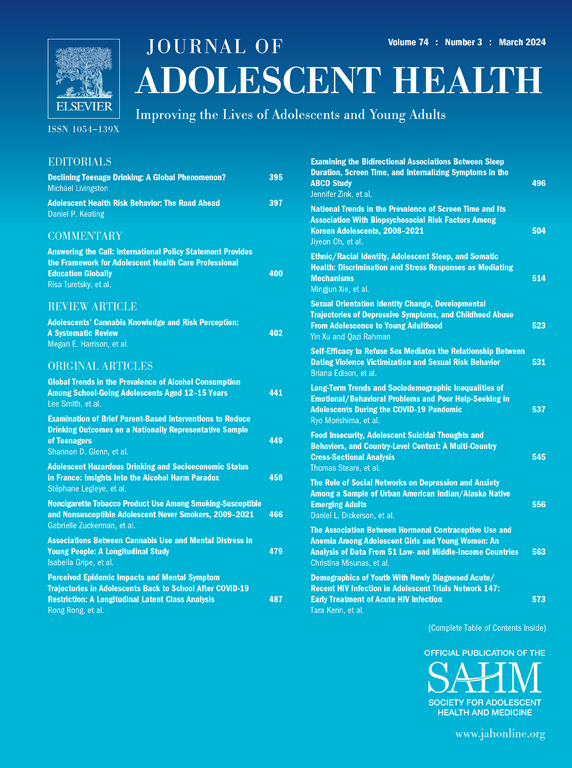心理社会因素在青少年性短信中的作用:风险感知的多国分析。
IF 5.5
2区 医学
Q1 PEDIATRICS
引用次数: 0
摘要
目的:通过对东部、南部非洲和东南亚13个国家的12-17岁上网儿童进行具有全国代表性的调查,本研究旨在研究与性短信相关风险感知相关的态度因素,并分析风险感知与性短信行为相关的程度。方法:以风险感知为结局变量进行多元线性回归分析。以风险感知和性短信(过去一年在网上分享自己的裸照或视频)为结果,绘制了每个国家的斜率,以检验各国风险感知和性短信行为之间的关系。结果:在几乎所有国家,更多的风险厌恶态度始终与风险感知呈正相关。绘制的风险感知和性短信的斜率,反过来,表明更高的风险感知与减少的性短信有关,在所有国家都有类似的方向。然而,水平各不相同,例如,在泰国和柬埔寨,风险感知对性短信有相似的影响(相同的斜率),但在很大程度上不同:在泰国发性短信的人仍然比在柬埔寨不发性短信的人有更高的担忧(风险感知= 4)。尽管与性短信相关的风险感知阈值范围值得注意,但限制性较少的态度和较低的风险感知与该领域的文献一致。这项研究为开发量身定制的方法的重要性提供了一些支持,这些方法要考虑到影响性短信的心理和环境因素,而不是一刀切的方法。本文章由计算机程序翻译,如有差异,请以英文原文为准。
The Role of Psychosocial Factors in Youth Sexting: A Multi-Country Analysis of Risk Perception
Purpose
Using nationally representative surveys with internet-using children aged 12–17 across 13 countries in Eastern and Southern Africa and Southeast Asia, the study aimed to examine attitudinal factors associated with sexting-related risk perception and analyze the extent to which risk perception is correlated with sexting behavior.
Methods
Multivariate linear regression with risk perception as the outcome variable was conducted. Slopes were plotted per country, with risk perception and sexting (having shared naked pictures or videos of self online in the past year) as the outcome, to examine the relationship between risk perception and sexting behavior across countries.
Results
More risk-averse attitudes were consistently positively associated with risk perception in almost all countries. Plotted slopes of risk perception and sexting, in turn, showed that higher risk perception was associated with reduced sexting, with similar directionality across all countries. However, the levels varied, e.g., in Thailand and Cambodia, risk perception had a similar effect on sexting (same slope) but at substantially different levels: those who sext in Thailand still have higher concerns (risk perception = 4) than those who do not sext in Cambodia (risk perception = 3).
Discussion
The finding that less restrictive attitudes and lower risk perception were correlated with sexting aligns with literature in the field, although the range of risk perception thresholds associated with sexting was noteworthy. The study provides some support for the importance of developing tailored approaches that take into consideration the psychological as well as contextual factors affecting sexting, as opposed to one-size-fits-all methods.
求助全文
通过发布文献求助,成功后即可免费获取论文全文。
去求助
来源期刊

Journal of Adolescent Health
医学-公共卫生、环境卫生与职业卫生
CiteScore
10.40
自引率
3.90%
发文量
526
审稿时长
46 days
期刊介绍:
The Journal of Adolescent Health is a scientific publication dedicated to enhancing the health and well-being of adolescents and young adults. Our Journal covers a broad range of research topics, spanning from the basic biological and behavioral sciences to public health and policy. We welcome a variety of contributions, including original research papers, concise reports, literature reviews, clinical case reports, opinion pieces, and letters to the editor. We encourage professionals from diverse disciplines such as Anthropology, Education, Ethics, Global Health, Health Services Research, Law, Medicine, Mental and Behavioral Health, Nursing, Nutrition, Psychology, Public Health and Policy, Social Work, Sociology, and Youth Development to share their expertise and contribute to our mission of promoting adolescent health. Moreover, we value the voices of young individuals, family and community members, and healthcare professionals, and encourage them to submit poetry, personal narratives, images, and other creative works that provide unique insights into the experiences of adolescents and young adults. By combining scientific peer-reviewed research with creative expressions, our Journal aims to create a comprehensive understanding of the challenges and opportunities in adolescent and young adult health.
 求助内容:
求助内容: 应助结果提醒方式:
应助结果提醒方式:


